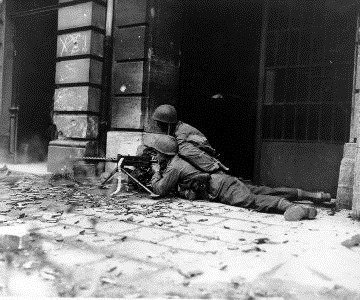Battle for Metz

Attacks by the 377th and 378th
 On 15 November the 377th and 378th, each minus on infantry battalion attached to Task Force Bacon on the east side of the river, started a co-ordinated maneuver, the 378th leading off with a flanking attack on the Canrobert line and the Feves ridge. The 377th, on the left, following up to make the main effort of the division with a push south along the west bank of the Moselle.
On 15 November the 377th and 378th, each minus on infantry battalion attached to Task Force Bacon on the east side of the river, started a co-ordinated maneuver, the 378th leading off with a flanking attack on the Canrobert line and the Feves ridge. The 377th, on the left, following up to make the main effort of the division with a push south along the west bank of the Moselle.
At 0800 on 15 November, after a fifteen-minute artillery preparation, the 1/378th and B Company, 778th Tank Battalion, moved forward to attack Fort le Feves, the northernmost work in the Canrobert line.By 1100 this key work, commanding the approaches to Metz from the north and northwest, was in American hands, and the attack rolled on toward the high ground southwest of the Bois de Woippy which was the regimental objective. During the afternoon troops of the 1010th Security Regiment and the 1215th Regiment made several furious but fruitless attempts to wipe out the American penetration in the rear of the Canrobert line. As each wave debouched from the German works it was cut down by fire from the lines of the 1/378. By midafternoon the 1010th and 1215th had had enough and were evacuating the line of fortifications in disorderly fashion. At 1600 the 3d Battalion passed through the gap made by the 1st Battalion and when night fell its troops were on the regimental objective.
T he main effort launched by the 95th Division on 15 November began at 1000 when the 377th Infantry Regiment drove south of Maizierres-les-Metz into the positions of the 1215th Regiment – now at only half strength. The infantry attack, spearheaded by medium tanks of the 778the Tank Battalion, made steady progress. At twilight the 3d Battalion held la Maxe and the 2d Battalion, to the west, was fighting hard in the town of Woippy – less than 3 miles from the heart of Metz – where the enemy had elected to make a stand with a battalion of the 1215th Regiment reinforced by the reserve company of the 38th SS Panzer Grenadier Regiment. The battle for Woippy continued until the afternoon of the following day, when the last Germans were captured or driven from the town. During the night of 15 November patrols from the 377th and 378th made contact, and the next day the bulk of the two regiments pushed to the south.
he main effort launched by the 95th Division on 15 November began at 1000 when the 377th Infantry Regiment drove south of Maizierres-les-Metz into the positions of the 1215th Regiment – now at only half strength. The infantry attack, spearheaded by medium tanks of the 778the Tank Battalion, made steady progress. At twilight the 3d Battalion held la Maxe and the 2d Battalion, to the west, was fighting hard in the town of Woippy – less than 3 miles from the heart of Metz – where the enemy had elected to make a stand with a battalion of the 1215th Regiment reinforced by the reserve company of the 38th SS Panzer Grenadier Regiment. The battle for Woippy continued until the afternoon of the following day, when the last Germans were captured or driven from the town. During the night of 15 November patrols from the 377th and 378th made contact, and the next day the bulk of the two regiments pushed to the south.
On 16 November all resistance by the 1215th Regiment collapsed. During the night of 16 November the attack of the 377th and 378th had turned into a pursuit along roads strewn with abandoned equipment, half-loaded truck, and artillery pieces. The following day the two regiments mopped up in the German works which had been bypassed, although Fort Gambetta was merely contained after the failure of an initial assault by troops of the 377th. The regiments then reorganized in preparation for the last stage of the advance into Metz.
Early on the morning of the 18 November the Germans blew the demolition charges on the Moselle bridges west of the city, destroying all but one, which apparently was left intact for the troops retreating from the bridgehead. The 377th, having reached the suburb of Sansonnet the previous evening, rushed a company of infantry and a few tanks across the one bridge over the Hafen Canal, which at this point turned west from the river to form a small island. The Americans took some 250 prisoners on the island. A patrol from the 3/378th Infantry rushed the bridge in its zone, but the structure was blown while the Americans were crossing.
 1/378th continued to assault forts around Metz without success. The next day XX Corp commander sent orders that all of the holdout forts were to be contained and not subjected to direct assault. The 378th, the 377th, and Task Force Bacon all entered Metz on 19 November.
1/378th continued to assault forts around Metz without success. The next day XX Corp commander sent orders that all of the holdout forts were to be contained and not subjected to direct assault. The 378th, the 377th, and Task Force Bacon all entered Metz on 19 November.





